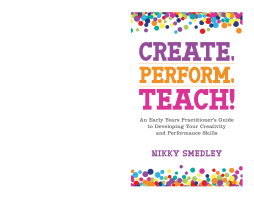
Additional Information
Book Details
Abstract
Using creative and performative methods is central to engaging children in fun and inspiring learning. This hands-on guide provides activities, quick tips and advice for developing performance and creative skills to support delivery of the Early Years Foundation Stage (EYFS).
Each chapter focuses on a particular method, including storytelling, role play, puppetry, sensory play, music and dance, and gives practitioners the confidence to develop and use these skills in their teaching. The book reveals how each method can be used to support key developmental aspects, such as language and communication, physical development and movement, listening and attention, and managing feelings.
Nikky Smedley has been creating and performing work for children for four decades. She works as an education consultant offering workshops on storytelling, performance and creativity and also played LaaLaa in Teletubbies for six years.
Table of Contents
| Section Title | Page | Action | Price |
|---|---|---|---|
| Create, Perform, Teach!: An Early Years Practitioner’s Guide to Developing Your Creativity and Performance Skills by Nikky Smedley | 3 | ||
| Introduction | 9 | ||
| Chapter 1. Who Is It? | 15 | ||
| Personal honesty is important; it’s what’s needed to make performance – and anything else – believable. So how do you bring your whole self to the classroom, modelling truthfulness and encouraging your children to feel safe enough to do the same themselves? | 15 | ||
| Chapter 2. Structuring the Class for Physicality | 29 | ||
| Let’s acknowledge the physical needs of young children. Here are some techniques to accommodate these needs whilst maintaining smooth running of the day. | 29 | ||
| Chapter 3. Can You Feel It? | 41 | ||
| Bringing the full five senses into the daily experience by introducing activities that cover the total sensory range. | 41 | ||
| Chapter 4. Real Role Play | 55 | ||
| Making role play in the classroom an effective tool for learning, whether in specified areas, in broader contexts, or in more practitioner-involved ways. | 55 | ||
| Chapter 5. Let Me See | 63 | ||
| How film and photography can be used as creative tools to embed learning and develop self-awareness. | 63 | ||
| Chapter 6. Bring the Noise! | 73 | ||
| Using music and vocalisation, not only as isolated events, but to assist learning throughout the day. | 73 | ||
| Chapter 7. Ssssssh! | 83 | ||
| The power and use of non-verbal communication. | 83 | ||
| Chapter 8. Telling the Story | 95 | ||
| Improving your own storytelling techniques, as well as using each story as stimulus for other learning. Plus how to help little ones invent and construct their own stories. | 95 | ||
| Chapter 9. Why Puppets? How Puppets? | 109 | ||
| Just that! The purposes for including puppets, how to really use them to bring the best out of your children and some tried and tested puppet projects to implement. | 109 | ||
| Chapter 10. Get Up and Boogie | 119 | ||
| You dancin’? If not, why not? Easy ways to get your children moving, inventing physically and learning about their bodies. Also how to calm them down again afterwards! | 119 | ||
| Chapter 11. Taking Care | 133 | ||
| Your well-being really matters too, so here are some suggestions for looking after yourself, so that you can look after the children even better. | 133 | ||
| Chapter 12. The Golden Rules | 145 | ||
| A summary of top tips and reminders from the checklists at the end of each chapter. | 145 | ||
| Index | 147 | ||
| Blank Page |
